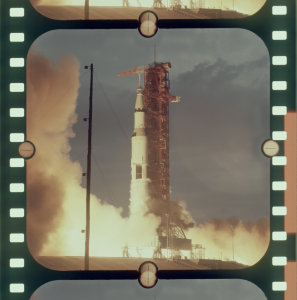
The movie First Man dramatises the story of Neil Armstrong’s famous giant leap for mankind. To give it a strong sense of authenticity, Director Damien Chazelle approached NASA to see if there was any archive footage from the Apollo era.
The good news was that NASA offered complete access to their archive material and there was plenty of footage from which to choose. For the Apollo 11 launch they had multiple cameras capturing different engineering details of the Saturn V from different angles. The bad news was that it was in a unique format: an obsolete 10-perf 70mm military stock developed by NASA using Kodak Ektachrome reversal film – the sprocket pitch in particular was incompatible with modern film scanning techniques.
David Keighley, president at IMAX, suggested a prototype scanner at FilmLight might offer a way to transfer the footage. Visual Effects Producer Kevin Elam also found there existed a gate made for a Rank Cintel telecine at the White Sands Missile Range, so whilst this could provide a telecine reference a modern scan quality was still desired.
Kodak developed a special Ektachrome reversal stock for NASA, with an extremely high dynamic range. That meant that all the detail of night-time launches could be captured, with the highlights of the rocket exhaust not burning out the detail of the activity around the launchpad.
Kevin Elam contacted FilmLight to see what could be done.
FilmLight is widely recognised, not just for its colour science, but for its understanding of the medium of film. Established in 2002, FilmLight develops unique colour grading systems, image processing applications and workflow tools for the film and video post production industry. FilmLight’s first product was the Northlight film scanner, a motion picture film scanner capable of scanning 16, 35 or 65 mm film formats.
Fortuitously, FilmLight has a continuing research project into advanced film scanning techniques, recognising that archive preservation is going to be a critical issue in the years to come. Archives come in very many formats, the majority long abandoned. But the deteriorating nature of much of the material, though, means that frequently conservationists get just one shot at scanning the film.
So one of the guiding principles of FilmLight’s research project – codename Arclight – is that it should be capable of scanning any piece of film, regardless of gauge or number and position of perforations. This seemed like an ideal test for the development.
Chris Hall leads the project for FilmLight, and he takes up the story. “I was sent a test film, and all I had to do was load it up and define an appropriate format in the software – the dimensions of the film frame and the sprockets,” he said. “The image area then came out as a square frame of just over 7000 lines: actually 7250 x 7250 pixels. That gave a very high-resolution scan of the images.
“While scanning this film, it started out almost completely opaque, but I was relieved to see the image of a rocket, on a launch stage, at night, clearly visible on the monitor.
“Then suddenly the film became almost transparent as the rockets fire,” he said. “The Ektachrome was slightly over-exposed at this point – which is completely understandable considering what it is pointed at. This range of densities is always a challenge for a film scanner, but we are pleased with the image quality capturing the full dynamic range. There was a lot of footage to scan, mostly of the actual launch of Apollo 11 with some shots of the other Apollo launches mixed in.”
In all, FilmLight scanned around 20 minutes of footage for the producers of First Man. The movie’s goal of true authenticity was greatly boosted by the inclusion of this material, and the exercise enhanced FilmLight’s understanding of the challenges around digitising archive footage at the highest possible quality.
# # #
About FilmLight
FilmLight develops unique colour grading systems, image processing applications and workflow tools that are transforming film and video post-production and setting new standards for quality, reliability and performance. The company’s streamlined metadata-based workflows employ robust products with cutting edge creative tools, allowing creative professionals to work at the forefront of the digital media revolution. Founded in 2002, FilmLight’s core business is centred on the innovation, implementation and support of its products—including Baselight, Prelight and Daylight—in leading production companies, post-production facilities and film/TV studios around the world. FilmLight is headquartered in London, where its research, design and manufacturing operations are centred. Sales and support are conducted through regional service centres and qualified partners worldwide. For more information, visit www.filmlight.ltd.uk



